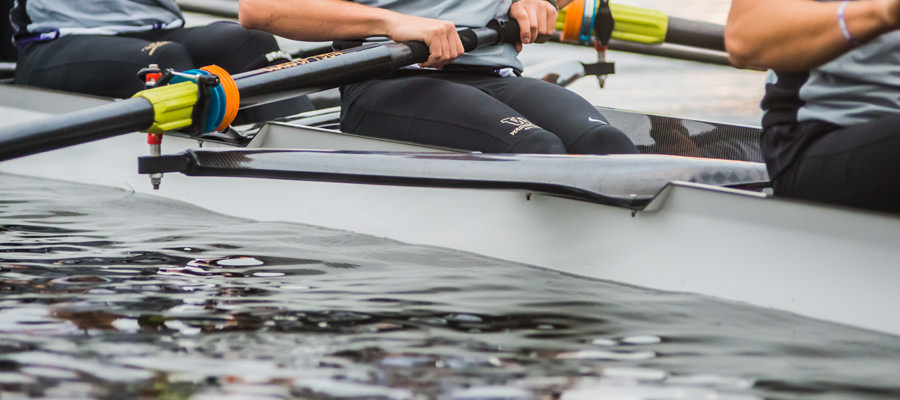Racing shells can accommodate a fairly large range of crew weights, but no one shell can accommodate the entire range. A design starts around a specific crew weight, which will float (or sink, depending on how you look at it) the boat to the designed water line. From that ‘ideal’ place, there is a range (usually 10-20 pounds above and below) of weight that the boat will comfortably accommodate. For example, a boat built for a crew with an average weight of 170 pounds should be fine for a range of 150-190. In a scenario with athletes who are either heavier or lighter than the weight which the hull was designed to displace, there are three areas of impact. Keep in mind these considerations when choosing the best hull, or adapting to a less than ideal boat in a pinch.
Changes in the waterline
Particularly in team boats, concern for an over- or under-weight crew changing the waterline is often overblown. The waterline changes ¼ of an inch for every 15 pound change in the average crew weight. So, a crew averaging 205 pounds will sink the waterline ½ an inch deeper than a crew averaging 175 pounds.
For coaches of team boats who are concerned about a crew at an extreme end of a prescribed weight range, or just outside of one, this should be a comforting fact. It takes a considerable amount of weight change in one direction or the other to have a consequential impact.
From what we hear from customers, there also appears to be a widespread belief that putting a bigger crew in a relatively smaller hull will create more wetted surface, and thus more drag, making it a less desirable option than a relatively larger hull. However, this belief is not quite true.
While a heavier crew will sink the boat more than a lighter crew in the same hull, they will have nearly identical wetted surface as they would in a larger hull; the hole they punch in the water will be the same size. So, under- or over-boating a crew will not create appreciably more or less wetted surface. It will only (slightly) change the shape of the surface that is underwater.
Seat height above the water
Per the ’15 lbs sinks a quarter inch’ rule, it takes quite a bit of weight change to affect where the boat sits in the water. But, for crews who are extremely over- or under-boated, seat height above the water, a big element of apparent stability and athlete comfort, will be affected.
A lighter crew will not sink the boat as much, so seats will float higher relative to the water, resulting in less stability. In this scenario, you would want to lower the rigging to get athletes comfortable. If they are really bobbing around, it might be difficult to lower it enough to find a strong position.
Conversely, a heavier crew will experience a greater sense of stability, but when seats get too close to the water line, the rowing geometry becomes awkward. Raising the rigging will help, but athletes will have a feeling of not being able to clear the water. There is a flatness to the angle between the athlete, oar, and water which can compromise the athlete’s ability to generate power.
Amount of exposed hull/freeboard
Since a lighter crew sinks the boat less, there will be more hull exposed to the air. In windy conditions, crews that are lighter than the designed displacement will get blown around more, but they will have more protection in rough water.
For crews who spend the majority of their time in rough water, this is a very real consideration to take into account when ordering shells.
A heavy crew will sink the boat more, lessening the effect of the wind on the hull, but the boat will be more prone to taking on water in rough conditions. If you constantly row on protected water, and you are borderline between two hull sizes, going with the smaller boat might be the better option.
Bottom line
Coaches, boards, and program managers have big decisions to make when it comes to boat purchases that will accommodate a diverse group of athletes. Take confidence in knowing the ’15 lb sinks a quarter inch’ rule, and in your ability to rig your way to comfort in a boat that may appear too big or too small when you first get into it.
Finally, many coaches just like a certain ‘look’ to a boat running through the water. Some fancy a ‘small’ boat that sits low in the water, while others like to see more freeboard, especially in the bow. As with everything in rowing, there are trade-offs that come with either aesthetic. Neither is more or less correct, and what is better on any given day often depends on conditions.




No Comments
No comments yet.
Sorry, the comment form is closed at this time.